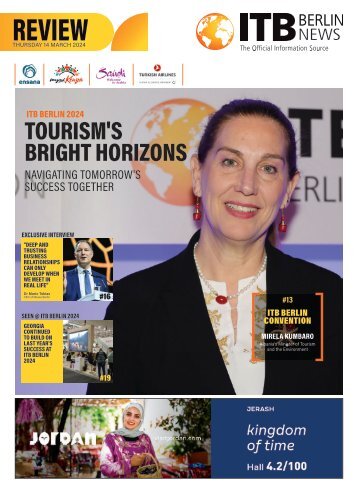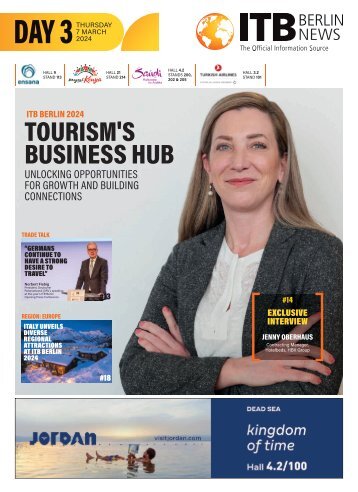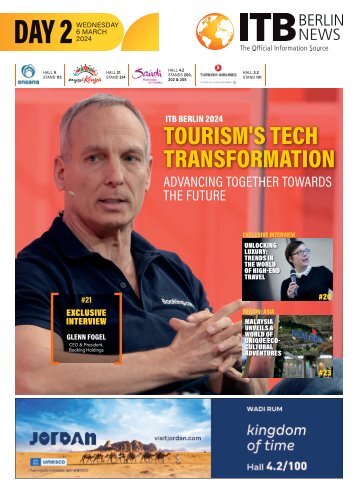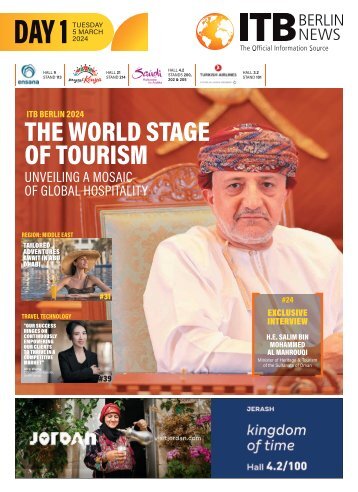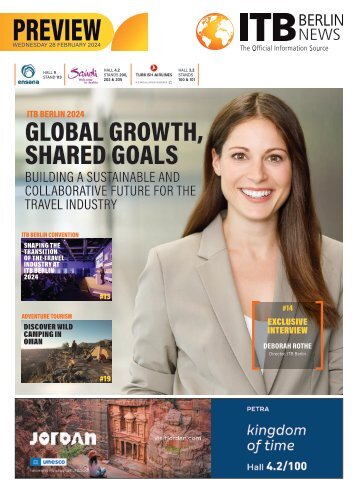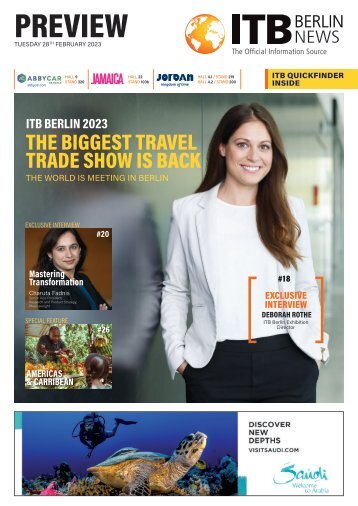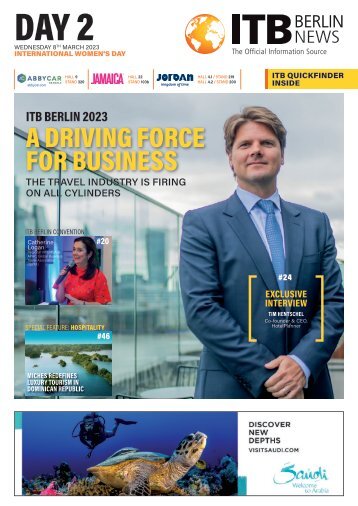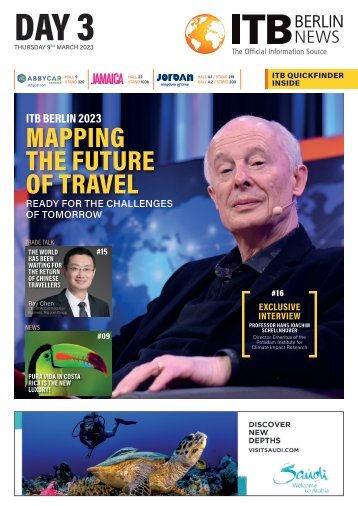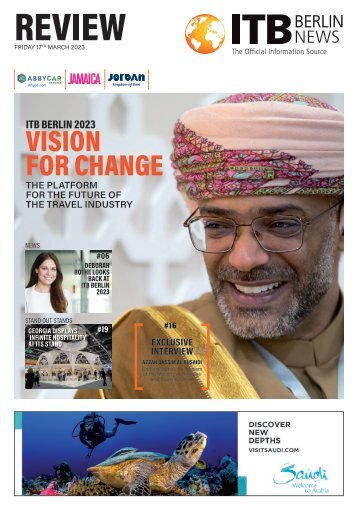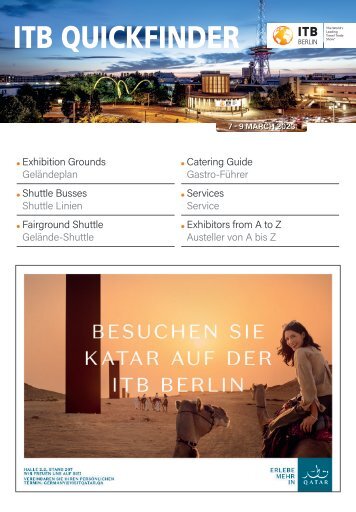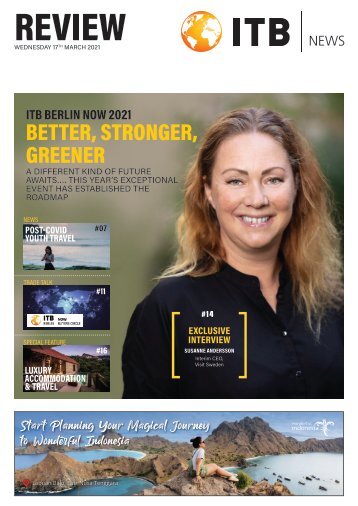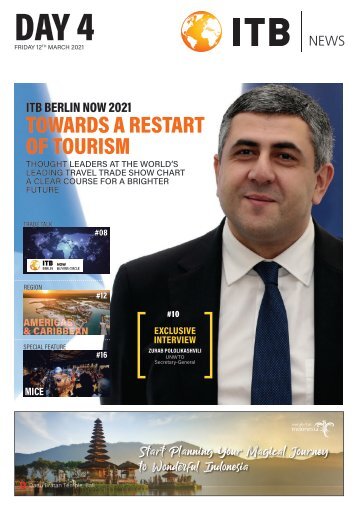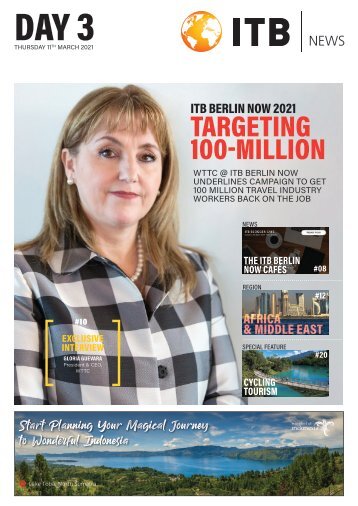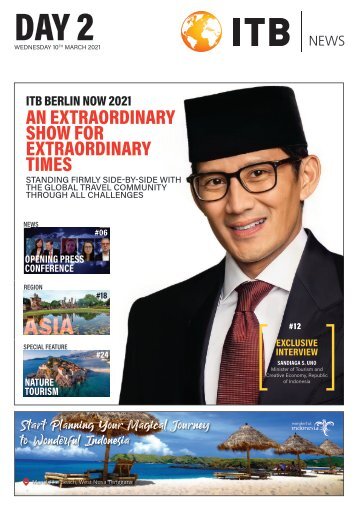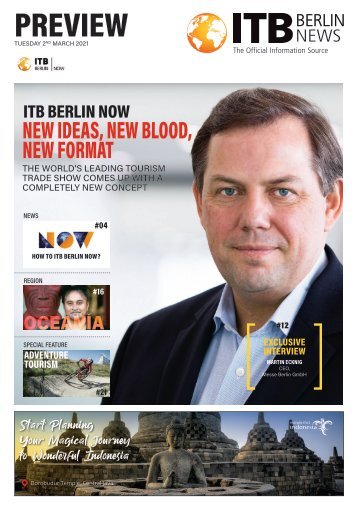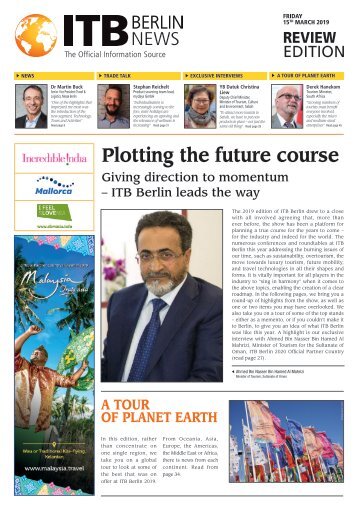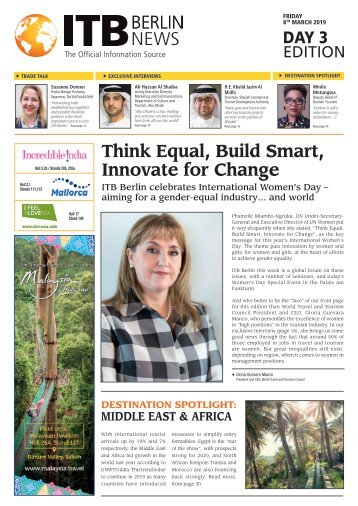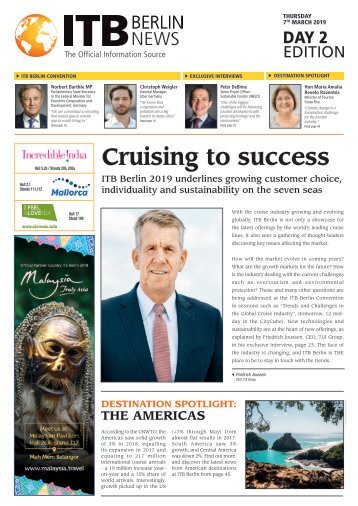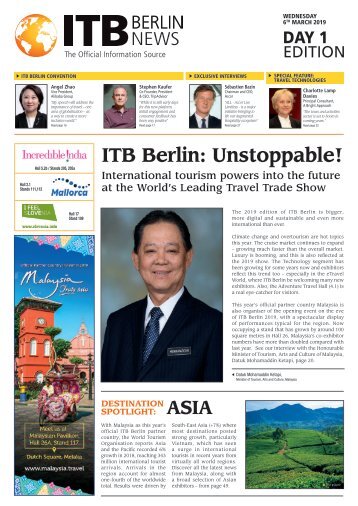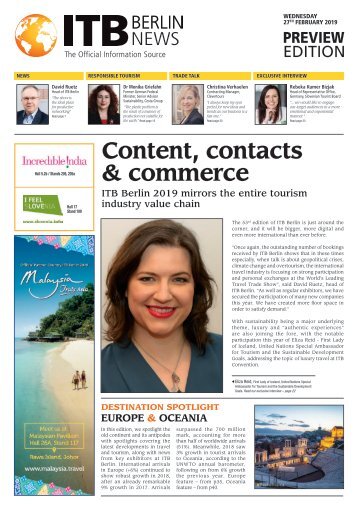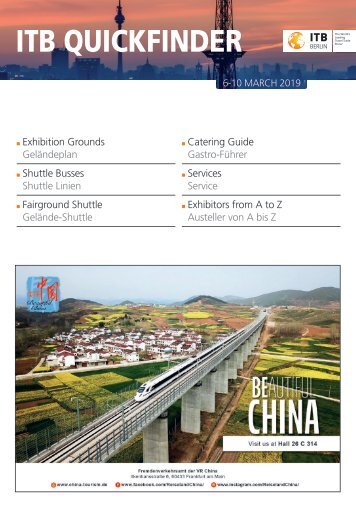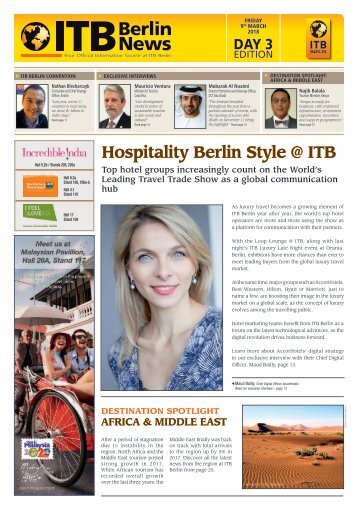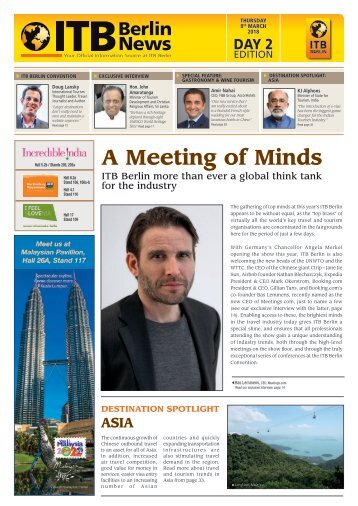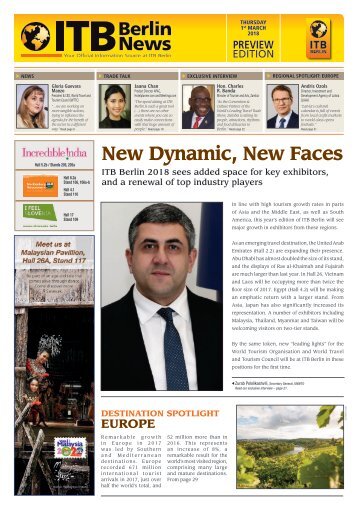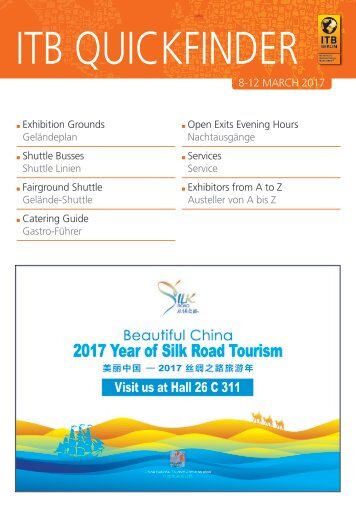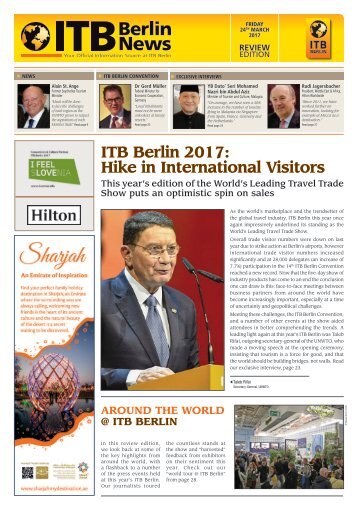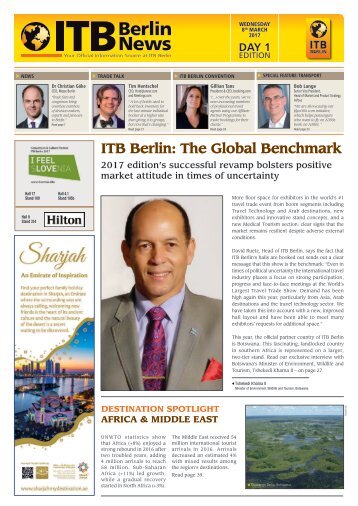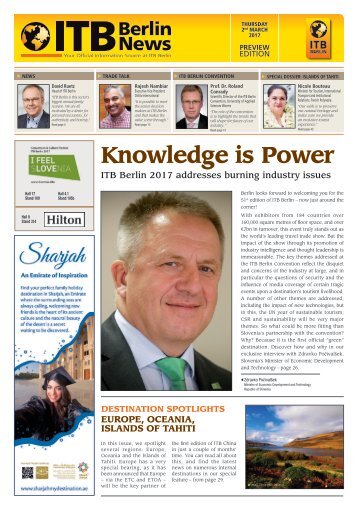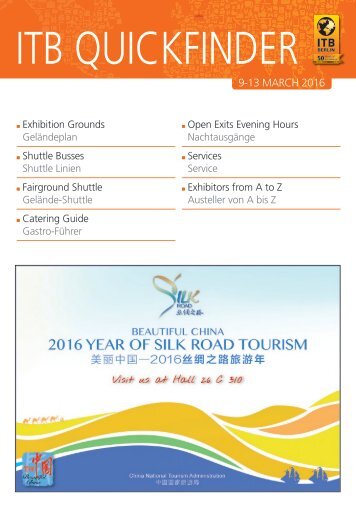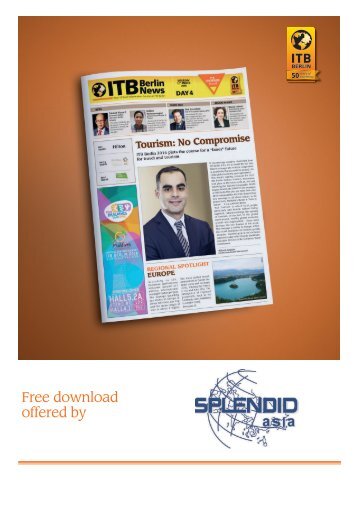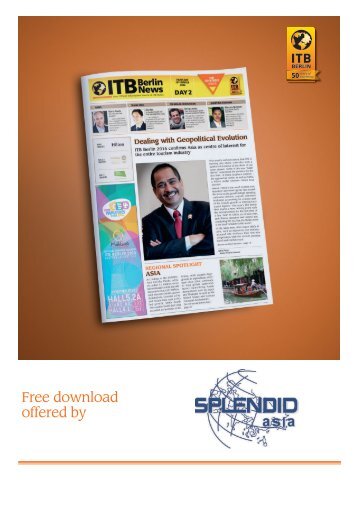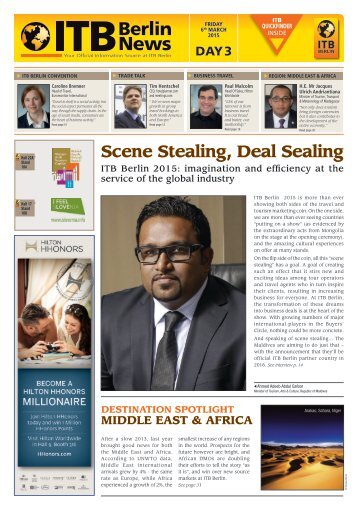
ITB Berlin News - Day 1
- Text
- Hotels
- Tourism
- Resort
- Tours
- Resorts
- Maldives
- Berlin
- Exhibitors
- Halle
- Tourismus
32 SPECIAL FEATURE
32 SPECIAL FEATURE TRAVEL CITY TECHNOLOGIES BREAKS Meeting Planning Just Got Easier Expedia introduces a dedicated MICE portal: MeetingMarket The MICE market continues to generate strong growth in a number of markets, yet the process for booking meetings has lagged behind other industries. Identifying a gap in the market, the Expedia group has launched the beta-version of MeetingMarket, the first portal that allows real-time booking of group accommodation, meeting rooms, food & beverage as well as equipment. After testing in Germany, the system will soon be set to roll out globally. We asked Felix Undeutsch, senior manager – MICE and groups, Expedia to tell us more… Up until now booking a meeting room and a group accommodation is essentially a lengthy and inefficient request for proposal process, regardless if done online or offline, regardless where in the world. True digitalisation in the MICE world happens just since a little more than one year, since 2015 first technologies were presented that offer instant availability and instant pricing. Both is crucial for instant booking. The MICE world therefore shifts from a “Request for Proposal” world to an “Instant”-world where quotes and availability is sent in real time, rather than manually after hours or days. Expedia Meeting Market is the very first booking platform that allows one to bundle meeting rooms, groups accommodation, food & beverage and equipment. All of this happens automatically with real time connectivity to hotel partners, no manual work for the hotels. Customers can compare prices of their meetings including lodging within seconds for a whole city; something that was not possible until now in the MICE world. Does such a system allow for much flexibility? Hotels have very detailed yield options and can bundle and customize their MICE packages very granularly. Customers on the other hand can customise their meeting by number of days, amount of rooms, by seating plan, adding equipment, such as projector, pin walls, sound systems, or adding food & beverage. 75% of the market is represented by not-fancy-at-all-standard business. This segment can easily be handled by our booking engine. Hoteliers benefit from the tool since there’s no manual quotation due to real time connectives, increased revenue per meeting due to endless revenue management options that didn’t exist in the MICE world until now as well as increased utilization of the meeting space due to our global reach. Hall 9 / Stand 322 Felix Undeutsch Senior manager – MICE and groups, Expedia ITB BERLIN NEWS • Wednesday 9 th March 2016 www.itb-berlin-news.com
TRANSPORT SPECIAL FEATURE 33 Transport @ ITB Berlin Demand for Air Travel in 2015 Surges to Strongest Result in Five Years As some say, “it’s all about the journey”, and at ITB Berlin this year, the arrival of new carriers puts the “transport” sector increasingly under the spotlight, as the success of the sector outshines many other parts of the global economy. Indeed, the International Air Transport Association (IATA) says global passenger traffic demand for 2015 rose 6.5% in terms of RPK (Revenue per Passenger Kilometre) for the full year compared to 2014. This was the strongest result since the post- Global Financial Crisis rebound in 2010 and well above the 10-year average annual growth rate of 5.5%. While economic fundamentals were weaker in 2015 compared to 2014, passenger demand was boosted by lower airfares. After adjusting for distortions caused by the rise of the US dollar, global airfares last year were approximately 5% lower than in 2014. “Last year’s very strong performance, against a weaker economic backdrop, confirms the strong demand for aviation connectivity. But even as the appetite for air travel increased, consumers benefitted from lower fares compared to 2014,” said Tony Tyler, IATA’s Director General and CEO. Annual capacity rose 5.6% last year, with the result that load factor climbed 0.6 percentage points to a record annual high of 80.3%. All regions experienced positive traffic growth in 2015. Carriers in the Asia-Pacific region accounted for one-third of the total annual increase in traffic. INTERNATIONAL PASSENGER MARKETS International passenger traffic rose 6.5% in 2015 compared to 2014. Capacity rose 5.9% and load factor rose 0.5 percentage points to 79.7%. All regions recorded year-over-year increases in demand. Asia Pacific carriers recorded a demand increase of 8.2% compared to 2014, which was the largest increase among the three largest regions. Demand was stimulated by a 7.3% increase in the number of direct airport connections in the region, resulting in time-savings for travellers. Capacity rose 6.4%, pushing up load factor 1.3 percentage points to 78.2%. European carriers’ international traffic climbed 5.0% in 2015. Capacity rose 3.8% and load factor increased 1.0 percentage point to 82.6%, highest among the regions. The healthy result in part was attributable to a pick-up in consumer spending in the Eurozone as well as a moderate increase in flight frequencies. Traffic growth slowed toward the end of the year owing to strikes at Lufthansa and the shutdown of Russia’s Transaero. North American airlines saw demand rise 3.2% in 2015, broadly unchanged from the growth achieved in 2014. Capacity rose 3.1%, edging up load factor 0.1 percentage points to 81.8%. Middle East carriers had the strongest annual traffic growth at 10.5%. As a result, the share of international traffic carried by Middle East airlines reached 14.2%, surpassing their North American counterparts (13.4%). Capacity growth of 13.2% exceeded the demand gains, pushing down load factor 1.7 percentage points to 76.4%. Latin American airlines’ traffic rose 9.3% in 2015. Capacity rose 9.2% and load factor inched up 0.1 percentage points to 80.1%. While key regional economies, particularly Brazil, have been struggling, overall traffic has been robust. African airlines had the slowest annual demand growth, up 3.0%, although THE HEALTHY RESULT IN PART WAS ATTRIBUTABLE TO A PICK-UP IN CONSUMER SPENDING IN THE EUROZONE AS WELL AS A MODERATE INCREASE IN FLIGHT FREQUENCIES this was a significant improvement over the 0.9% annual growth achieved in 2014. With capacity up just half as much as traffic, load factor climbed 1 percentage point to 68.5%. International traffic rose strongly in the second half of 2015, in conjunction with a jump in trade activity to and from the region. Tony Tyler Director General and CEO, International Air Transport Association (IATA) Dec 2015 vs. Dec 2014 RPK Growth ASK Growth PLF International 5.6% 5.9% 78.1 Domestic 5.1% 4.2% 79.9 Total Market 5.4% 5.3% 78.8 YTD 2015 vs. YTD 2014 RPK Growth ASK Growth PLF International 6.5% 5.9% 79.7 Domestic 6.3% 5.2% 81.5 Total Market 6.5% 5.6% 80.3 DOMESTIC PASSENGER MARKETS Domestic air travel rose 6.3% in 2015. All markets showed growth, led by India and China but there was wide variance. Capacity rose 5.2% and load factor was 81.5%, up 0.9 percentage points over 2014. ITB BERLIN NEWS • Wednesday 9 th March 2016
- Page 1 and 2: Free download offered by
- Page 3: WEDNESDAY 9 th MARCH 2016 DAY 1 ITB
- Page 7 and 8: NEWS 5 FROM ‘66TO‘16 50 gloriou
- Page 9: NEWS 7 NOT TO BE MISSED! Today, Wed
- Page 14: 12 NEWS The Evolution of the Travel
- Page 21 and 22: ITB BERLIN CONVENTION 19 ITB Berlin
- Page 23: EXCLUSIVE INTERVIEW 21 National Eco
- Page 27 and 28: CITY BREAKS SPECIAL FEATURE 25 Djem
- Page 29 and 30: CITY BREAKS SPECIAL FEATURE 27 ADVE
- Page 31 and 32: CITY BREAKS SPECIAL FEATURE 29 ADVE
- Page 33: TRAVEL TECHNOLOGIES SPECIAL FEATURE
- Page 37 and 38: TRANSPORT SPECIAL FEATURE 35 Singap
- Page 39: TRANSPORT SPECIAL FEATURE 37 EMPOWE
- Page 45: SPECIAL DOSSIER: MALDIVES 43 2016:
- Page 48 and 49: ITB BERLIN NEWS • Wednesday 9 th
- Page 51: SPECIAL DOSSIER: MALDIVES 49 : A
- Page 55 and 56: SPECIAL DOSSIER: MALDIVES 53 Smart,
- Page 57: SPECIAL DOSSIER: MALDIVES 55 ADVERT
- Page 61: SPECIAL DOSSIER: MALDIVES 59 When S
- Page 64 and 65: 62 SPECIAL DOSSIER: MALDIVES MORE G
- Page 67 and 68: AFRICA & MIDDLE EAST REGION 65 Fami
- Page 69 and 70: AFRICA & MIDDLE EAST REGION 67 Keny
- Page 71 and 72: © Thomas Keller HOSPITALITY / REST
- Page 75 and 76: ITB QUICKFINDER 9-13 MARCH 2016 Exh
- Page 77 and 78: Hall 26 A / Stand 106b Hall 26 A /
- Page 79 and 80: CATERING GUIDE & OPEN EXITS EVENING
- Page 81 and 82: EXHIBITORS FROM A TO Z / AUSTELLER
- Page 83 and 84: A / B EXHIBITORS / AUSSTELLER HALL
- Page 85 and 86:
B / C EXHIBITORS / AUSSTELLER HALL
- Page 87 and 88:
C / D / E EXHIBITORS / AUSSTELLER H
- Page 89 and 90:
E / F / G EXHIBITORS / AUSSTELLER H
- Page 91 and 92:
G / H / I EXHIBITORS / AUSSTELLER H
- Page 93 and 94:
I / J / K / L EXHIBITORS / AUSSTELL
- Page 95 and 96:
L / M / N EXHIBITORS / AUSSTELLER H
- Page 97 and 98:
N / O / P / Q EXHIBITORS / AUSSTELL
- Page 99 and 100:
Q / R / S EXHIBITORS / AUSSTELLER H
- Page 101 and 102:
S / T EXHIBITORS / AUSSTELLER HALL
- Page 103 and 104:
T / U / V EXHIBITORS / AUSSTELLER H
- Page 105:
V / W / X / Y / Z EXHIBITORS / AUSS
Inappropriate
Loading...
Embed
Loading...
